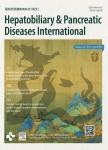Relationship between intestinal microbial dysbiosis and primary liver cancer
Relationship between intestinal microbial dysbiosis and primary liver cancer作者机构:Key Laboratory of Desert and Desertification Northwest Institute of Eco-Environment and Resources Chinese Academy of Sciences Key Laboratory of Extreme Environmental Microbial Resources and Engineering of Gansu Province University of Chinese Academy of Sciences The First Clinical Medical College Lanzhou University The First Hospital of Lanzhou University Lanzhou University Key Laboratory of Biotherapy and Regenerative Medicine of Gansu Province
出 版 物:《Hepatobiliary & Pancreatic Diseases International》 (国际肝胆胰疾病杂志(英文版))
年 卷 期:2019年第18卷第2期
页 面:149-157页
核心收录:
基 金:supported by grants from National Natural Science Foundation of China(31570509 and 31770536)
主 题:Gut microbiota Microbial dysbiosis Hepatocarcinogenesis 16S rDNA
摘 要:Background: Intestinal microbial dysbiosis is involved in liver disease pathogenesis. However, its role in primary liver cancer(PLC), particularly in hepatocarcinogenesis remains unclear. The present study aimed to study the changes in intestinal flora at various stages of PLC and clarify the relationship between intestinal microbes and PLC. Methods: Twenty-four patients with PLC(PLC group), 24 patients with liver cirrhosis(LC group), and 23 healthy control individuals(HC group) were enrolled from October 2016 to October 2017. Stool specimens of the participants were collected and the genomic DNA of fecal bacteria was isolated. High-throughput pyrosequencing of 16 S r DNA was used to identify differences in gut bacterial diversity among HC, LC, and PLC groups. We also analyzed the relationship between clinical factors and intestinal microorganisms in LC and PLC groups. Results: Diversity of Firmicutes tended to decrease from the HC to LC and PLC groups at the phylum level. Among species, Enterobacter ludwigii displayed an increasing trend in the PLC group, wherein the relative abundance of Enterobacter ludwigii in the PLC group was 100 times greater than that in the HC and LC groups. The ratio of Firmicutes/Bacteroidetes was significantly decreased with the disease progression. In addition, the linear discriminant analysis effect size method indicated that Clostridia were predominant in the gut microbiota of the HC group, whereas Enterococcaceae, Lactobacillales, Bacilli and Gammaproteobacteria may be used as diagnostic markers of PLC. Redundancy analysis showed a correlation between intestinal microbial diversity and clinical factors AST, ALT, and AFP. Veillonella showed a significant positive correlation with AFP in the PLC group, whereas Subdoligranulum showed a negative correlation with AFP. Conclusions: This study indicates that dysbiosis of the gut microbiota might be involved in PLC development and progression.



